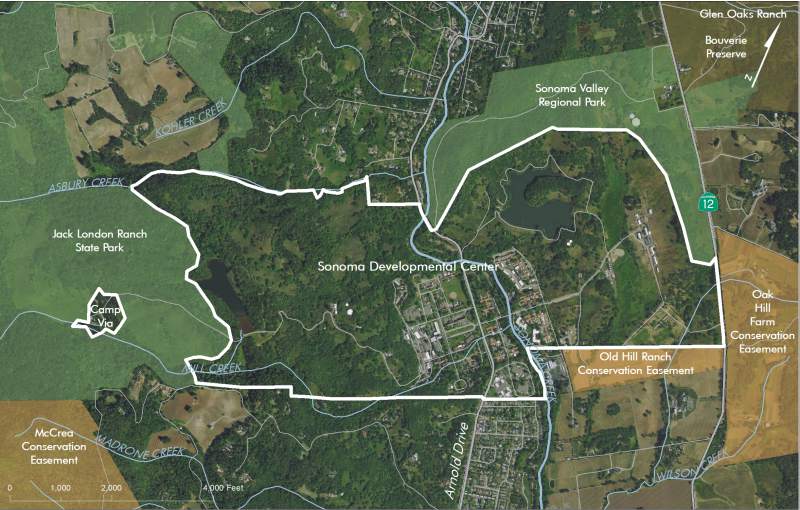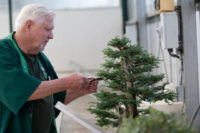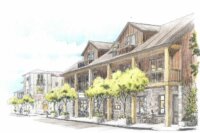By Teri Shore —
The future of the 945-acre expanse of open space lands and historic campus in the heart of Sonoma Valley remains uncertain after the latest public hearing on county plans to create a new town.
At a Board of Supervisors meeting on January 25, where about 50 people called for a change of course, Supervisor Susan Gorin directed county planners to revise the proposed plans to incorporate public comment to better protect open space and the wildlife corridor, scale back housing and increase affordability, and seek funding for state-of-the-art redevelopment of the historic campus, ideally through a public or nonprofit trust and not by sale to a private developer.
Environmentalists called for immediate transfer of open space lands to parks. Housing advocates called for more affordable housing and fewer, if any, market rate homes. Labor called for a Community Benefits Agreement at the site. In a surprise twist, political operative Doug Bosco pitched a climate research center at SDC, that might be funded by the Coastal Conservancy, of which he is chair.
No one spoke in support of the proposed plans.
In response, Gorin made a strong case for reducing the housing units proposed from 1,000 to a range of 450 to 700 with more deed-restricted affordable housing. She also wished to prevent vacation rentals, Pacaso-style timeshares, and second homes at SDC. She called on the state to step up and invest in the clean-up of the site to make it more financially feasible for possibilities, such as a climate research center.
Supervisors did not vote or pass a resolution, but have tasked the planning staff with making the changes. A delay to give more time was not granted, and a hotel remains in the mix along with a possible new road through a voter-protected community separator.
The plans are widely opposed due to the size and scale of the proposed development. The abandoned campus is surrounded by open space, agricultural lands, and voter-approved community separator greenbelts.
At the end of 2021, Sonoma County planners released three similar variations of urban-style development on the historic campus that features 1,000 homes, a new hotel, restaurants, commercial and office space, and a new road. The draft plans were intended as the foundation for developing a county SDC Specific Plan that will undergo formal environmental review.
The initial plans were widely opposed by environmentalists, housing advocates, labor, community groups, and the public at large. Hundreds of letters were lodged with the county and state. The Sonoma City Council and Sonoma Valley’s two county-appointed Municipal Advisory Councils opposed the plans and made recommendations.
Next Steps
The board won’t see the plans again until at least September 2022, after the EIR and public hearings before the county planning commission.
The next step will be a public meeting to determine what to study in the environmental review process under the California Environmental Quality Act sometime in February, when the next iteration of the SDC Specific Plan will be released. A Specific Plan is essentially a mini-General Plan to determine land uses specific to a given property or area, in this case SDC.
The board of supervisors won’t see the plans again until at least September 2022, after the EIR and public hearings before the county planning commission.
County planners claimed that the state would not allow any time extension due to a contract signed with the State of California in December 2019 before COVID to complete the SDC Specific Plan and environmental review with three years. However, the county got behind due to the COVID crisis and wildfires and is now rushing to put through a large development plan by the end of 2022.
Background
The 945-acre property is owned by the State of California. It was closed in 2018, the last of the state hospitals to do so. The County of Sonoma is leading the public process to provide a plan and vision for the land before the State sells, leases, exchanges, or otherwise transfers the property, per state legislation. Community visioning for the land has been underway for five years or more, but very few of the concepts for an environmentally sound and small scale reuse of the property were included in the county plans.
As proposed, the plans would comprise the biggest subdivision and development in the history of Sonoma Valley – equal in housing units to the sprawling Temelec, Chanterelle and 7 Flags subdivisions on the south end of Sonoma Valley. All alternatives would drastically increase driving and associated Vehicle Miles Traveled and Greenhouse Gas Emissions, and undermine decades of city-centered growth policies. The plans also conflict with local, county, regional and state polices to reduce climate-changing emissions, achieve equitable housing and preserve biodiversity.
While most people agree that some level of affordable housing may be appropriate, the county is proposing 25 percent of the total for deed-restricted affordable housing. That ratio is likely to create an upper class enclave with about 750 market rate homes and 250 deed-restricted affordable squeezed in between. Whether that affordable housing would qualify for state funding is questionable since the state prioritizes transit-oriented urban infill sites and SDC is not near a major transit stop or shops, schools or services.
The 745 acres of existing open space is prioritized for permanent conservation. However, the protection of the wildlife corridor, Sonoma Creek and other natural features were given little attention. The Sonoma Valley Wildlife Corridor https://sonomalandtrust.org/current-initiatives/sonoma-valley-wildlife-corridor/ is a critical link for multiple keystone species such as mountain lions, bears and badgers to travel from as far as the Berryessa-Snow Mountain Wilderness to the East to the Pt. Reyes National Seashore and Sonoma Coast. Millions of public and private funds have been invested in acquiring lands and protecting the wildlife corridor for decades.
State legislation requires the conservation of SDC’s open space, prioritizing affordable housing as determined to be appropriate for the property, as well as to increase land values, expedite marketing, and maximize interested third-party potential purchasers. Read the state law here:
It was written in 2019 before the state surplus, before COVID, and before many new climate, housing and conservation investments and polices were adopted by the Newsom administration. For example, SDC’s open space lands could be incorporated into the State of California’s new initiative to conserve 30 percent of the state’s lands by 2030, known as 30 X 30. It is time to review and revise the state law.
Teri Shore is an environmental policy and communications consultant.






Be First to Comment